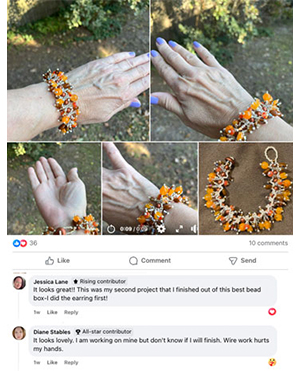- Jewelry-Making Supplies ▾
Design Jewelry with Confidence!
Seed Beads
Thread, Wire, & Stringing Materials
Athenacast Findings & Components
Everything Else
- Kits & Collections ▾
Assemble Your World
Kits & Collections
- Subscriptions ▾
Want monthly Beading Happiness?
Subscriptions
- Learn to Make ▾
Want to learn more?
- Discounts & Deals ▾
Explore Today's Promotions!
- Jewelry-Making Supplies
- Kits & Collections
- Subscriptions
- Learn to Make
- Discounts & Deals
-
Seed Beads
Thread, Wire, & Stringing Materials
Findings & Components
Everything Else
-
Kits & Collections
-
Subscriptions
- Home
- How to Make Jewelry
- Better Beader Episodes
- What Are Crystal? Glass vs Natural
What Are Crystal? Glass vs Natural

Watch the Video Tutorial
Watch the Video Tutorial
- 00:00Current time04:56
Need Any Extra Materials?
Need Any Extra Materials?
Need Any Extra Materials?
Need Any Extra Materials?
Episode Transcript
Episode Transcript
Introduction
Crystals have long been admired for their beauty and believed to possess various healing properties. In this Better Beader episode from Potomac Beads, we dive into the fascinating world of crystals, exploring the differences between glass and natural crystals. Whether you're a jewelry maker looking to incorporate these stunning elements into your designs or simply curious about their origins and characteristics, this article will provide you with valuable insights and information.
Types of Crystals
- Glass Crystals: Man-made crystals that are designed to resemble natural crystals, offering a wide range of colors, shapes, and sizes. They are often more affordable and consistently available compared to natural crystals.
- Natural Crystals: Formed through geological processes over millions of years, natural crystals are mined from the earth. Each crystal is unique, with its own variations in color, clarity, and inclusions. Some popular natural crystals include amethyst, citrine, and quartz.
Characteristics of Glass Crystals
- Glass crystals are made from a combination of sand, lead, and other minerals, which are melted together at high temperatures.
- They are often cut and polished to enhance their brilliance and symmetry.
- Glass crystals can be coated with special finishes, such as Aurora Borealis (AB), to create iridescent effects.
- Popular glass crystal brands include Swarovski, Preciosa, and Chinese crystals.
Characteristics of Natural Crystals
- Natural crystals are formed through various geological processes, such as magmatic crystallization, metamorphism, or precipitation from hydrothermal fluids.
- Each crystal has its own unique energy and vibrational frequency, believed to influence physical, emotional, and spiritual well-being.
- Natural crystals may have inclusions, which are solid or liquid matter trapped within the crystal during its formation. These inclusions can add to the crystal's character and uniqueness.
- The color of natural crystals can vary depending on the presence of trace elements or impurities.
Incorporating Crystals into Jewelry
Both glass and natural crystals can be beautifully incorporated into jewelry designs. Here are some ideas:
- Use glass crystals to add sparkle and color to earrings, necklaces, or bracelets.
- Create wire-wrapped pendants showcasing natural crystal points or tumbled stones.
- Combine glass and natural crystals in a single piece for a unique and eclectic look.
- Choose crystals based on their believed metaphysical properties to create meaningful and intentional jewelry pieces.
Conclusion
Understanding the differences between glass and natural crystals allows you to make informed choices when selecting materials for your jewelry projects. Whether you prefer the consistent sparkle of glass crystals or the one-of-a-kind beauty of natural crystals, both offer endless creative possibilities. Embrace the magic of crystals and let them inspire your next beading adventure!
For more informative content and beading inspiration, be sure to check out other Better Beader episodes from Potomac Beads. Happy beading!
Join Our Growing Community
Join Our Growing Community




Our Testimonials
Our Testimonials
- 55773 (83.7%)
- 4784 (11.4%)
- 3283 (4.1%)
- 229 (0.4%)
- 126 (0.4%)
- Favorite Reviews
- Highest to Lowest
- Newest to Oldest
- All Ratings
- 5 ★ Reviews
- 4 ★ Reviews
- 3 ★ Reviews
- 2 ★ Reviews
- 1 ★ Reviews
Loading...
Only Visible on Admin Mode
Item Description
Designer's Material List
Project Steps
Highest Quality
Products
100% Money
Back Guarantee
Fast
Shipping
Best Teaching &
Customer Service
You'll want these emails...
Get Free Projects & Inspiration
Get Free Projects & Inspiration
- Bullet 1
- Bullet 2
- Bullet 3
Copyright © PotomacBeads









